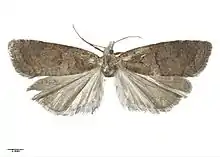Epichorista tenebrosa
Epichorista tenebrosa is a species of moth in the family Tortricidae. This species is endemic to New Zealand. It is found in Otago and has been collected in tussock grassland habitats. It is a late autumn emerging moth and adults are on the wing in February. It is classified as "At Risk, Relict'" by the Department of Conservation.
| Epichorista tenebrosa | |
|---|---|
 | |
| Male | |
| Scientific classification | |
| Kingdom: | |
| Phylum: | |
| Class: | |
| Order: | |
| Family: | |
| Genus: | |
| Species: | E. tenebrosa |
| Binomial name | |
| Epichorista tenebrosa | |
Taxonomy
This species was first described by Alfred Philpott in 1917 from a specimen collected at Ben Lomond by Charles E. Clarke in February.[2][3] George Hudson discussed and illustrated this species in his 1928 book The Butterflies and Moths of New Zealand.[4] The genus level classification of New Zealand endemic moths within Epichorista is regarded as unsatisfactory and is under revision.[5] As such this species is currently also known as Epichorista (s.l.) tenebrosa.[1] The type specimen is held at the Auckland War Memorial Museum.[3]
Description
.jpg.webp)
Philpott described the species as follows:
♂︎ 25-28 mm. ; ♀︎ 22 mm. Head and palpi ochreous-grey mixed with brown, palpi 3. Antennal ciliations of ♂︎ 1+1⁄2. Thorax purplish-brown sprinkled with brown. Abdomen ochreous-grey. Forewings elongate-triangular in ♂︎, suboblong in ♀︎, costa almost straight, without fold, apex obtuse, termen subsinuate, hardly oblique ; dull grey-brawn with purplish gloss and numerous obscure strigulations of reddish or fuscous ; margin of basal patch usually indicated by a more pronounced irregular strigula ; median fascia from 1⁄3 costa, irregular, outwardly oblique, inner margin only marked : cilia grey mixed with brown. Hindwings fuscous-grey, obscurely mottled with darker : cilia grey with darker basal line.[2]
Distribution

This species is endemic to New Zealand.[6] It is found in the Otago. As well as its type locality, this species has also been found in Naseby State Forest, at Roaring Meg and South Rough Ridge Hill.[7]
Habitat
Hudson noted that the type specimen was found at an altitude of 4000 ft in tussock grasslands.[4] The species has subsequently been collected from similar habitat.[7]
Conservation status
This moth is classified under the New Zealand Threat Classification system as being "At Risk, Relict".[9]
References
- "Epichorista tenebrosa Philpott, 1917". www.nzor.org.nz. Landcare Research New Zealand Ltd. Retrieved 2018-05-17.
- Philpott, A. (1917). "Descriptions of new species of Lepidoptera". Transactions and Proceedings of the New Zealand Institute. 49: 239–245. Retrieved 17 May 2018.
- Dugdale, J. S. (1988). "Lepidoptera - annotated catalogue, and keys to family-group taxa" (PDF). Fauna of New Zealand. 14: 123. Retrieved 16 May 2018.
- Hudson, G. V. (1928). The Butterflies and Moths of New Zealand. Wellington: Ferguson & Osborn Ltd. p. 237. OCLC 25449322.
- Patrick, Brian (2014-12-01). "Conservation status of five data deficient moth taxa: Epichorista lindsayi, "Cnephasia" paterna, Stathmopoda endotherma, Gymnobathra ambigua and Scythris "stripe"". The Weta. 48: 15–34.
- Gordon, Dennis P., ed. (2010). New Zealand inventory of biodiversity: Kingdom animalia : chaetognatha, ecdysozoa, ichnofossils. Vol. 2. p. 464. ISBN 978-1-877257-93-3. OCLC 973607714. OL 25288394M. Wikidata Q45922947.
- Barratt, B. I. P.; Patrick, B. H. (1987). "Insects of snow tussock grassland on the East Otago Plateau". New Zealand Entomologist. 10 (1): 69–98. doi:10.1080/00779962.1987.9722513. Retrieved 17 May 2018.
- "Lammermoor Windfarm Decision" (PDF). www.qldc.govt.nz. Environment Court of New Zealand. 2009. Retrieved 17 May 2018.
- Hoare, R.J.B.; Dugdale, J.S.; Edwards, E.D.; Gibbs, G.W.; Patrick, B.H.; Hitchmough, R.A.; Rolfe, J.R. (2017). Conservation status of New Zealand butterflies and moths (Lepidoptera), 2015 (PDF). Wellington, New Zealand: New Zealand Department of Conservation. p. 8. ISBN 9781988514383.
